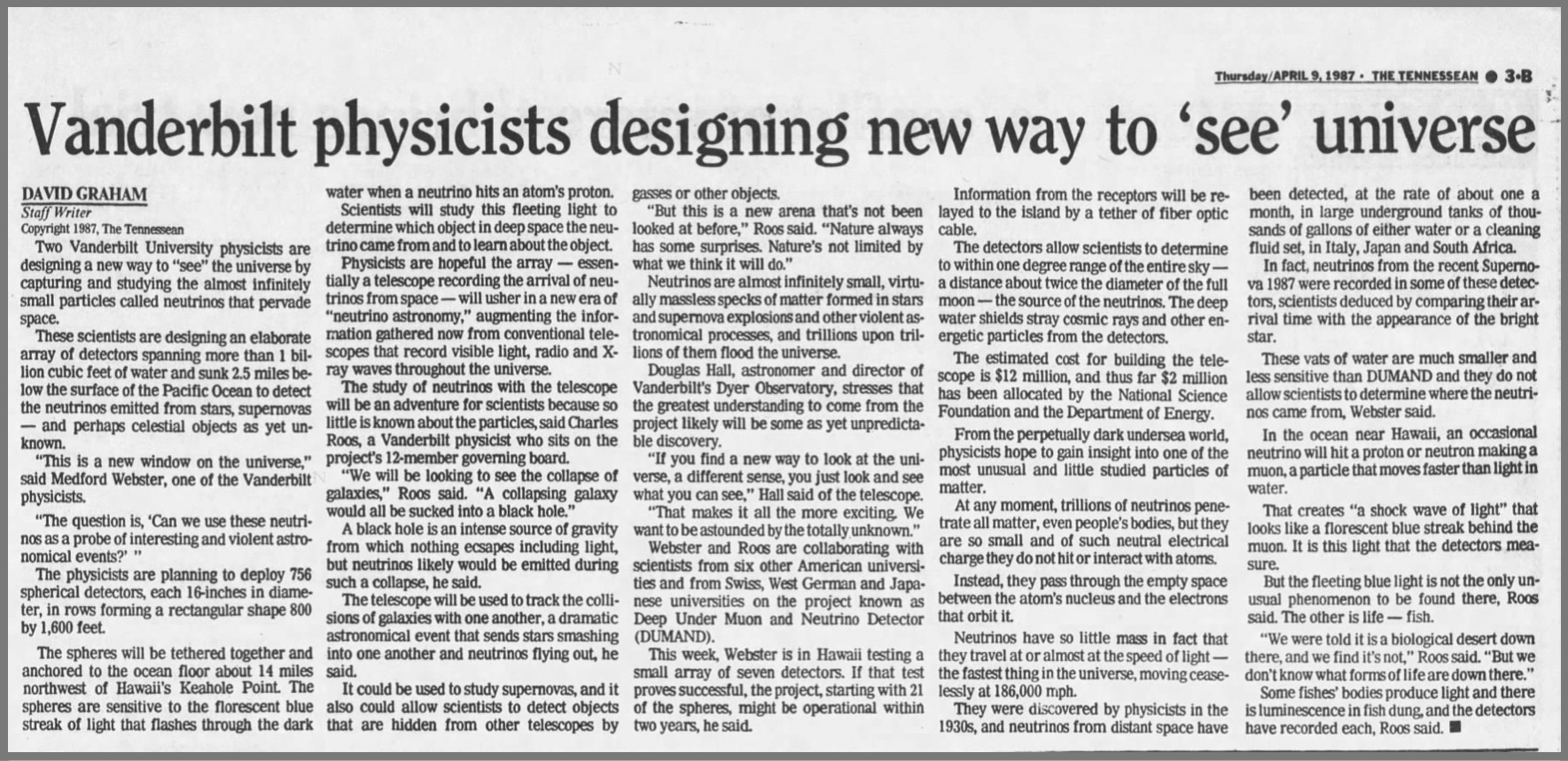On this date (April 9) in 1987, Vanderbilt University physicists announced a project named Deep Under Muon and Neutrino Detector (DUMAND) to study neutrinos, tiny particles that escape from stars and violent events such as supernovae. The scientists involved were especially interested in the interaction of collapsing galaxies and black holes. Vanderbilt University physicists Medford Webster and Charles Roos served on a team that designed an array of 756 spherical detectors to be placed 2.5 miles below the surface of the Pacific Ocean northwest of Hawaii’s Keahole Point. The 800 by 1600-foot rectangle that the detectors formed would function much as a very large submerged telescope that would detect neutrinos passing through. Dyer Observatory’s Director at the time, the well-known local authority on astronomy Dr. Douglas Hall, was asked for comment. He proposed that an unpredicted discovery could be the most instructive, “If you find a new way to look at the universe, a different sense, you just look and see what you can see.” Unfortunately, the project was canceled in 1995 after short circuits prevented communication with the underwater hardware. The hardware was then donated to the NESTOR project in Greece.
The field of neutrino research has had an interesting history. The almost-massless particles were first theorized to exist before they were detected. When the first detectors were brought online in the 1960s, only one-third of the predicted neutrinos were detected. This became known as the “solar neutrino problem,” and astronomers concluded that either the detectors were insufficient, the neutrino was misunderstood, or both. It turns out that it was both. Further research suggested that neutrinos could change, or oscillate, between three different types, which colloquially became known as “changing flavors.” If that was true, then the first neutrino detectors would only be able to detect one type known as the electron-neutrino. Once additional detectors were designed and constructed to be able to detect the other two types of neutrinos, astronomers were able to breathe – the remaining two-thirds of the predicted neutrinos were also observed.
Observing neutrinos is no easy task because they so rarely interact with ordinary matter. As you have been reading this, more than a trillion could have passed through you, mostly originating from the Sun as hydrogen is fused into helium. The best neutrino detectors still are only able to detect one out of every 1022 neutrinos that pass through them.
<- Previous April 9, 2020 Next ->
Tucked up among the wooded hilltops of northern Brentwood, Vanderbilt Dyer Observatory is considered by many to be a hidden treasure of the area. Visitors to our satellite campus not only learn about some of the cutting-edge discoveries and science in astronomy but they also get a dose of nature, history, and many other things while here. Over the years, we at Dyer Observatory have made the preservation of our facility and grounds a key mission. Preservation not only entails things such as maintaining our telescopes — it also includes keeping a record of days passed. Since 1953, we have amassed a number of interesting images, pieces of equipment, and ephemera. Every day tends to bring new surprises. In continuing our tradition of public education and outreach, Stellar Finds regularly provides an image and description of the diverse paraphernalia associated with Vanderbilt Dyer Observatory and the history of astronomy at Vanderbilt University.
